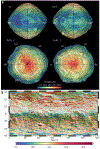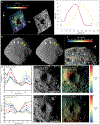Shape of (101955) Bennu indicative of a rubble pile with internal stiffness
- PMID: 31080497
- PMCID: PMC6505705
- DOI: 10.1038/s41561-019-0330-x
Shape of (101955) Bennu indicative of a rubble pile with internal stiffness
Abstract
The shapes of asteroids reflect interplay between their interior properties and the processes responsible for their formation and evolution as they journey through the Solar System. Prior to the OSIRIS-REx (Origins, Spectral Interpretation, Resource Identification, and Security-Regolith Explorer) mission, Earth-based radar imaging gave an overview of (101955) Bennu's shape. Here, we construct a high-resolution shape model from OSIRIS-REx images. We find that Bennu's top-like shape, considerable macroporosity, and prominent surface boulders suggest that it is a rubble pile. High-standing, north-south ridges that extend from pole to pole, many long grooves, and surface mass wasting indicate some low levels of internal friction and/or cohesion. Our shape model indicates that, similar to other top-shaped asteroids, Bennu formed by reaccumulation and underwent past periods of fast spin leading to its current shape. Today, Bennu might follow a different evolutionary pathway, with interior stiffness permitting surface cracking and mass wasting.
Figures




References
-
- Nolan M et al. Shape model and surface properties of the OSIRIS-REx target asteroid (101955) Bennu from radar and lightcurve observations. Icarus 226, 629–640. (2013).
-
- Hergenrother CW et al. Lightcurve, color and phase function photometry of the OSIRIS-REx target asteroid (101955) Bennu. Icarus 226, 663–670 (2013).
-
- Gaskell RW, et al. Characterizing and navigating small bodies with imaging data. Meteorit. Planet. Sci. 43, 1049–1061 (2008).
-
- Daly MG, et al. The OSIRIS-REx Laser Altimeter (OLA) Investigation and Instrument. Space Sci. Rev. 198, 1–26. (2017).
Grants and funding
LinkOut - more resources
Full Text Sources
Miscellaneous
